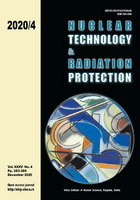
INDOOR RADON ACTIVITY CONCENTRATION AND EFFECTIVE DOSE RATES AT SCHOOLS AND THERMAL SPAS OF ILGIN

Vol.
XXXV, No. 4, Pp. 283-386
December 2020
UDC 621.039+614.876:504.06
ISSN 1451-3994
Pages: 339-346
Authors: Mehmet Erdogan, Murat Abaka, Kaan Manisa, Hasan Bircan, Coskun Kus,
and Veysel ZedefAbstract
Indoor radon activity concentrations and radon doses on the ground floor and basement floor of 19 schools (kindergardens, primary schools, secondary schools, and high schools) and thermal spas of Ilgin district in Konya, have been measured using the AlphaGUARD PQ 2000PRO radon detector, for three days in the first half of 2016. According to the results, while the indoor radon concentration for only one location, in total, is above the Turkish action level of 400 Bqm–3, the values for 10 locations are above the reference level of 100 Bqm–3, recommended by WHO. The calculated annual effective doses for inhalation of the radon in indoor air were also found to be 0.26 µSv for the minimum and 4.36 µSv for the maximum. The parametric distribution analysis is also performed with 3-parameter Weibull distribution and some remarks are provided on radon concentration activity.
Key words: annual effective dose, Ilgin active fault, indoor radon, statistical modelling, Weibull distribution
FULL PAPER IN PDF FORMAT (1.18 MB)